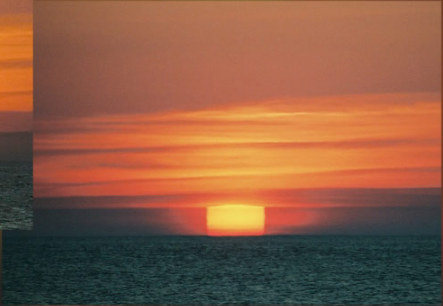Baltic Refractions
Baltic Refractions: Exploring the Enigmatic Sunset Mirage
Have you ever witnessed a mesmerizing sunset over the Baltic Sea? The ethereal beauty of this natural spectacle is often enhanced by a fascinating atmospheric phenomenon known as Baltic refractions. In this article, we will delve into the captivating world of Baltic refractions and unravel the science behind these optical illusions.
The Enigma of Baltic Refractions
Baltic refractions occur when a strong temperature inversion takes place over the sea, characterized by abnormally warm air overlaying cooler air. This inversion creates distinct layers of air with varying temperatures and densities. As the sun's rays pass through these different layers, they become refracted and curved, resulting in the formation of a ducted mock-mirage sunset.
The Intricate Dance of Light
When witnessing a Baltic refraction, one may observe at least three solar images, each equally "real" in appearance. The uppermost image is upright and descending, while within the inversion layer, one image appears inverted and rising. The third image is upright and setting. This complex interplay of light and atmospheric conditions gives rise to a breathtaking display that can leave observers in awe.
Unveiling the Science
To comprehend the science behind Baltic refractions, we must understand the role of temperature inversions. Normally, air temperature decreases with increasing altitude. However, in the case of a temperature inversion, warm air becomes trapped above cooler air, creating a stable layer of varying temperatures. This inversion layer acts as a refractive medium for sunlight, causing the bending and curving of light rays.
Exploring Atmospheric Optics
Baltic refractions fall under the realm of atmospheric optics, a branch of science that investigates the behavior of light in the Earth's atmosphere. This field encompasses various phenomena, including mirages, halos, rainbows, and more. By studying atmospheric optics, scientists gain insights into the intricate interactions between light, air, and particles, leading to a deeper understanding of our atmospheric environment.
The Significance of Observations
Observations of Baltic refractions provide valuable data for atmospheric researchers. By analyzing these optical phenomena, scientists can gain insights into the temperature profiles and stability of air layers in the atmosphere. This information contributes to weather forecasting models and helps improve our understanding of atmospheric dynamics.
Capturing the Beauty
Photographers and enthusiasts alike are captivated by the enchanting allure of Baltic refractions. These atmospheric phenomena offer unique opportunities for artistic expression and visual storytelling. The interplay of light and air creates ever-changing landscapes that photographers can immortalize through their lenses, sharing the beauty of nature's optical wonders with the world.
Beyond the Baltic Sea
While Baltic refractions are particularly prominent over the Baltic Sea, similar phenomena can occur in other locations worldwide. Temperature inversions are not exclusive to this region, and under specific atmospheric conditions, other bodies of water can also exhibit captivating refractive effects. Exploring different locations and their unique atmospheric optics offers a diverse range of visual experiences.
Inspiring Wonder
Baltic refractions serve as a reminder of the boundless wonders that nature holds. These captivating displays ignite a sense of wonder and curiosity within us, prompting us to explore and understand the world around us. By delving into the science behind Baltic refractions, we gain a deeper appreciation for the intricacies of our atmosphere and the awe-inspiring phenomena it can produce.
Embracing Nature's Mysteries
In a world where so much is known and understood, Baltic refractions remind us that there is still much to discover and unravel. Nature's mysteries continue to captivate and astound us, inviting us to embrace the unknown and explore the enigmatic depths of our planet's atmospheric phenomena. So next time you find yourself gazing at a sunset over the Baltic Sea, take a moment to marvel at the mesmerizing dance of light and appreciate the beauty of Baltic refractions.

Sunset Mirage over the Baltic Sea imaged at Rowy, Poland by Robert Tyszek of Warsaw. Images ©Robert Tyszek, shown with permission.

A strong temperature inversion, consisting of abnormally warm air overlaying cooler air, is present over the sea. Its upper boundary can be seen where the upper solar image is cut off. The sun's rays are refracted and curved as they pass between the air layers of different temperature and density to produce a ducted mock-mirage sunset. There are at least three solar images - all equally "real". The upper one is upright and descending and within the inversion layer one image is inverted and rising whilst the third is upright and setting.
Note: this article has been automatically converted from the old site and may not appear as intended. You can find the original article here.
Reference Atmospheric Optics
If you use any of the definitions, information, or data presented on Atmospheric Optics, please copy the link or reference below to properly credit us as the reference source. Thank you!
-
<a href="https://atoptics.co.uk/blog/baltic-refractions/">Baltic Refractions</a>
-
"Baltic Refractions". Atmospheric Optics. Accessed on December 27, 2024. https://atoptics.co.uk/blog/baltic-refractions/.
-
"Baltic Refractions". Atmospheric Optics, https://atoptics.co.uk/blog/baltic-refractions/. Accessed 27 December, 2024
-
Baltic Refractions. Atmospheric Optics. Retrieved from https://atoptics.co.uk/blog/baltic-refractions/.